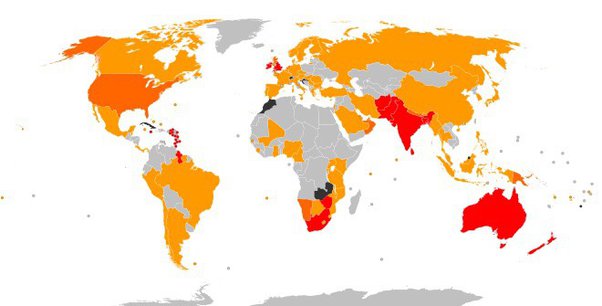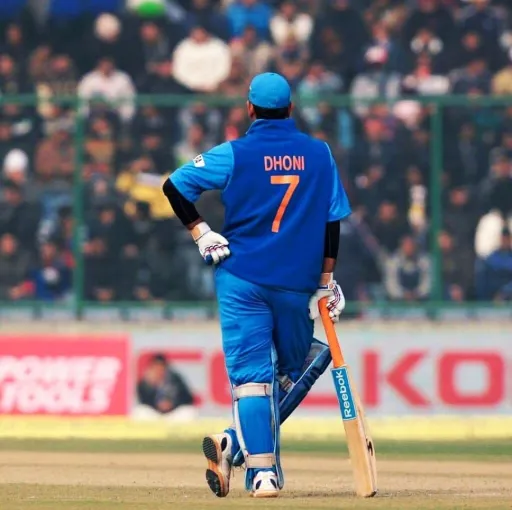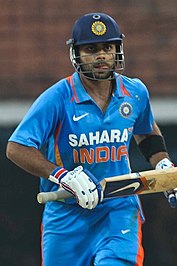Which Country Does Not Play Cricket ?
Introduction
Cricket, often dubbed as a gentleman’s game, holds immense popularity in various parts of the world, especially in countries like India, Australia, England, and Pakistan. However, there are regions where cricket has not gained widespread traction and remains relatively unknown or unplayed. In this article, we delve into the countries where cricket isn’t a popular sport and explore the reasons behind its limited presence.
Some of the Countries which do not play cricket are:
- United States of America
- China
- Russia
- Brazil
- Indonesia
- Nigeria
- Iceland
- Norway
- Sweden
- Finland
- Mexico
- Argentina
- South Africa
- Canada
- Germany
These countries either have minimal participation in cricket, lack infrastructure, or have other sports that dominate the sporting landscape.
Countries Which Do Not Play Cricket

1. United States of America (USA):
Cricket in the USA has historically struggled to compete with mainstream sports like American football, basketball, and baseball. Despite its early roots in the country and occasional surges in popularity, cricket has failed to establish itself as a major sport. Limited infrastructure, lack of exposure, and competition from other sports have hindered its growth. However, efforts are being made to promote cricket in the USA, with initiatives like the Major League Cricket aiming to popularize the sport and attract a wider audience.
2. China:
Despite being the most populous country globally, cricket has failed to gain significant traction in China. The sport faces stiff competition from traditional Chinese sports like table tennis, badminton, and basketball, which enjoy widespread popularity. Limited awareness, lack of infrastructure, and cultural differences pose significant challenges to cricket’s expansion in China. However, there have been sporadic efforts to promote the sport, including cricket clinics and coaching programs, but its impact remains limited.
3. Russia:
In Russia, cricket remains a niche sport with minimal participation and spectator interest. The country’s harsh climate, preference for winter sports like ice hockey and skiing, and limited exposure to cricket have contributed to its marginal status. While there are a handful of cricket clubs and enthusiasts in major cities like Moscow and St. Petersburg, the sport struggles to attract mainstream attention. Lack of government support, infrastructure, and funding further impede cricket’s growth in Russia.
4. Brazil:
Despite its vibrant sports culture, cricket has failed to make significant inroads in Brazil. Football, volleyball, and mixed martial arts dominate the sports landscape, leaving little room for cricket to flourish. Limited awareness, lack of facilities, and absence of a strong cricketing tradition are among the key factors hindering its popularity. However, there have been grassroots efforts to introduce the sport in schools and communities, but its adoption remains limited compared to other sports.
5. Indonesia:
In Indonesia, cricket remains a relatively obscure sport with minimal participation and fan following. The country’s preference for sports like football, badminton, and basketball, coupled with limited exposure to cricket, has hindered its growth. Despite efforts by cricket associations and enthusiasts to promote the sport, challenges such as lack of infrastructure, funding, and government support persist. Cricket’s niche status in Indonesia reflects the dominance of other sports in the country’s sporting landscape.
6. Nigeria:
While Nigeria boasts a rich sporting heritage, cricket struggles to gain traction amidst competition from football, athletics, and boxing. Limited infrastructure, lack of exposure, and socio-economic factors pose challenges to cricket’s development in the country. Despite efforts by cricket associations and international bodies to promote the sport, it remains largely confined to urban areas and elite circles. However, there is potential for cricket to grow in Nigeria with sustained investment, grassroots development, and community engagement initiatives.
7. Iceland:
In Iceland, cricket is a relatively new and niche sport with a small but dedicated community of players and enthusiasts. The country’s cold climate, limited playing facilities, and lack of cricketing tradition present significant challenges to the sport’s growth. However, initiatives like the Iceland Cricket Association and the establishment of cricket clubs have helped raise awareness and attract interest among locals and expatriates. Cricket’s presence in Iceland may be modest, but its enthusiasts are determined to expand its reach and promote the sport.
While cricket enjoys widespread popularity in many parts of the world, there are countries where the sport struggles to gain a foothold. Factors such as cultural preferences, lack of infrastructure, and competition from other sports pose significant challenges to cricket’s expansion in these regions.
Reasons Why Some Countries Do Not Play Cricket

Several factors contribute to the lack of popularity or absence of cricket in certain countries. These reasons vary from cultural preferences and historical influences to logistical challenges and competition from other sports. Let’s explore some of the primary reasons:
- Cultural Preferences: In countries where cricket is not traditionally played, cultural preferences often favor other sports like football, basketball, or baseball. These sports have deeper roots and enjoy greater popularity, making it challenging for cricket to compete for attention and resources.
- Historical Influences: The colonial history of cricket has significantly influenced its spread across the globe. Countries like England, India, Australia, and the West Indies were former British colonies, where cricket was introduced and ingrained as a legacy of colonial rule. In contrast, countries without a colonial history or strong ties to cricket-playing nations may not have adopted the sport to the same extent.
- Lack of Infrastructure and Facilities: Developing and maintaining cricket infrastructure, such as stadiums, training facilities, and coaching programs, requires significant investment and resources. In countries where cricket is not a priority sport, limited infrastructure and facilities hinder the growth and development of the game.
- Limited Exposure and Awareness: In regions where cricket is not widely televised or promoted, there is limited exposure and awareness of the sport among the general population. Without sufficient media coverage and marketing efforts, cricket struggles to attract new fans and participants.
- Logistical Challenges: Geography, climate, and logistical challenges can also impact the feasibility of playing cricket in certain countries. For example, extreme weather conditions or lack of suitable playing surfaces may restrict opportunities for cricket to flourish.
Capabilities and Potential for Cricket in Non-Playing Countries

While cricket may face obstacles in gaining traction in non-playing countries, there are still opportunities for growth and expansion. Several factors indicate the potential for these countries to embrace cricket in the future:
- Diverse Population: Many non-playing countries have diverse populations with roots in cricket-playing nations. Immigrant communities and expatriates from countries like India, Pakistan, Bangladesh, and the Caribbean bring their love for cricket with them, creating a potential fan base and talent pool.
- Globalization and Connectivity: Globalization and digital connectivity have made it easier for cricket to reach new audiences and markets. With the proliferation of streaming platforms, social media, and online content, cricket can overcome geographical barriers and engage fans worldwide.
- Youth Participation and Development: Investing in youth participation and development programs is crucial for introducing cricket to new generations and nurturing talent. Schools, clubs, and grassroots initiatives can play a vital role in promoting the sport and identifying future stars.
- International Exposure and Events: Hosting international cricket events, such as ICC tournaments, can raise the profile of the sport in non-playing countries and generate interest among local communities. Exposure to top-level competition and participation in global events can inspire aspiring cricketers and fans alike.
- Adaptation and Innovation: Adapting the format and rules of cricket to suit local preferences and conditions can make the sport more accessible and appealing to new audiences. Shorter formats like T20 cricket, street cricket, and indoor cricket variations offer flexibility and innovation in engaging diverse communities.
Exploring Potential Pathways for Growth Of Cricket
While cricket may face obstacles in certain countries, there are avenues for expansion and inclusion that can help broaden the sport’s reach globally. These include:
- Development Programs: Implementing grassroots development programs and initiatives to introduce cricket to schools, communities, and recreational clubs.
- Strategic Partnerships: Collaborating with local governments, sports organizations, and corporate sponsors to invest in cricketing infrastructure and promotional activities.
- Media and Broadcasting: Increasing visibility through television broadcasts, online streaming platforms, and social media to engage new audiences and generate interest in cricket.
- International Outreach: Leveraging international cricketing events, such as the ICC World Cup and T20 tournaments, to showcase the sport and foster cross-cultural exchanges.
- Youth Engagement: Engaging youth through youth leagues, coaching clinics, and talent identification programs to nurture future generations of cricketers and enthusiasts.
FAQs
Which countries do not play cricket?
While cricket is played and followed in many countries around the world, there are several nations where the sport does not have a significant presence or following.
What are some examples of countries that do not play cricket?
Examples of countries where cricket is not widely played include the United States, China, Russia, Brazil, Japan, and Nigeria, among others.
Why do these countries not play cricket?
The reasons vary depending on the country but often include a lack of historical connection to the sport, the dominance of other sports within the country, and limited infrastructure and resources for cricket development.
What are the primary sports played in these countries instead of cricket?
In countries like the United States, basketball, American football, and baseball are more popular. In China, sports like basketball, table tennis, and badminton take precedence. Similarly, Russia favors ice hockey, football, and volleyball, while Brazil is known for its passion for football, volleyball, and mixed martial arts (MMA).
Is cricket completely absent in these countries?
While cricket may not be as prevalent or popular as in traditional cricket-playing nations, it is not entirely absent in these countries. There are efforts to promote the sport through grassroots initiatives, expatriate communities, and international tournaments.
Are there any efforts to introduce cricket in these countries?
Yes, various organizations, including the International Cricket Council (ICC) and national cricket boards, are actively working to promote cricket in non-traditional markets. This includes initiatives to develop infrastructure, introduce cricket programs in schools, and organize tournaments to raise awareness and participation.
Can cricket gain popularity in these countries in the future?
While it may be challenging, cricket has the potential to gain popularity in non-traditional markets over time. Factors such as globalization, increased media coverage, and the growing diversity of populations in these countries could contribute to the gradual growth of cricket as a sport of interest.




